abab experimental design In an ABAB Reversal design an experimenter rotates two or more conditions and has a participant complete several consecutive sessions in each condition. The study by Hall and his colleagues was an ABAB reversal design.
Abab Experimental Design, Reversal designs are particularly useful for the evaluation of medication effects because they provide additional information about the effectiveness of treatment. ABAB Design Case study. ABA therapy utilizes behavioral principles to set goals reinforce behaviors and measure outcomes.
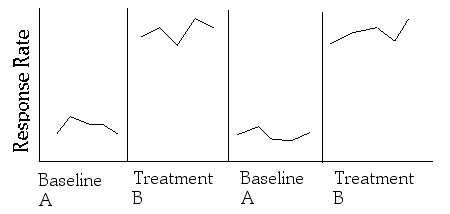 Abab Gif From csus.edu
Abab Gif From csus.edu
For example it might be used to establish a functional relationship between the use of the plural form of a noun and a treatment such as praise following the occurrence of a plural noun. ABA design also known as a withdrawal or reversal design is a type of single subject experimental design which allows researchers to investigate the effectiveness of an intervention. The A-B-A-B design is recommended for use when reversal designs can be used and when the patients treatment phase needs to be maintained. The percentage of time he spent studying the dependent variable was low during the first baseline phase increased during the first treatment phase until it leveled off decreased during the second baseline phase and again increased during the second treatment phase. The A-B-A-B design represents an attempt to measure a baseline the first A a treatment measurement the first B the withdrawal of treatment the second A and the re-introduction of treatment the second B.
Ethical and reversal issues exeducation cant be taken away.
Reversal designs are particularly useful for the evaluation of medication effects because they provide additional information about the effectiveness of treatment. To demonstrate effectiveness of the treatment a change must be observed under multiple circumstances to rule. Drawbacks to ABAB and reversal designs are ethical concerns and the irreversibility of certain targets. In order for this design to provide evidence that the intervention was effective. Additionally many clinicianseducators prefer the ABAB design because the investigation ends with a treatment phase rather than the absence of an intervention.
Another Article :

The ABAB design is intended to reveal a functional relationship between an experimental treatment and a behavior targeted for change. Ethical and reversal issues exeducation cant be taken away. Additionally many clinicianseducators prefer the ABAB design because the investigation ends with a treatment phase rather than the absence of an intervention. To demonstrate effectiveness of the treatment a change must be observed under multiple circumstances to rule. What is the primary advantage of ABAB design. In order for this design to provide evidence that the intervention was effective. Hypothetical Example Of An Abab Design Onghena 1992 Download Scientific Diagram.

Welcome to Behaviorbabe - Single Subject Designs - This site was created for multiple reasons. For example it might be used to establish a functional relationship between the use of the plural form of a noun and a treatment such as praise following the occurrence of a plural noun. Typically an experimenter rotates baseline and intervention conditions. Withdrawal designs also known as ABAB designs rely on the comparisons between conditions when an intervention is in place and conditions when that intervention is not being implemented. To demonstrate effectiveness of the treatment a change must be observed under multiple circumstances to rule. The study by Hall and his colleagues was an ABAB reversal design. Reversal Designs Open Textbooks For Hong Kong.

Withdrawal designs also known as ABAB designs rely on the comparisons between conditions when an intervention is in place and conditions when that intervention is not being implemented. The self-injurious behaviors included pulling her hair biting her arm and banging her head against the all. This approach is often described as the gold standard in the treatment of autism. ABAB Design An ABAB design is similar to an ABA design except after the post-treatment measurement period the intervention is re-introduced B with the assumption that the treatment effect will return. To demonstrate effectiveness of the treatment a change must be observed under multiple circumstances to rule. Combining two or more single-case designs such as ABAB and multiple baseline stems from a need to obtain answers to more complex research questions Changing criterion design A criterion for reinforcement is changed across the experiment to demonstrate a functional relation between reinforcement and behavior. Sage Reference The Sage Encyclopedia Of Abnormal And Clinical Psychology.

ABAB designs have the benefit of an additional demonstration of experimental control with the reimplementation of the intervention. ABAB Design Case study. Single-subject research is a group of research methods that are used extensively in the experimental analysis of behavior and applied behavior analysis with both human and non-human participants. In an ABAB Reversal design an experimenter rotates two or more conditions and has a participant complete several consecutive sessions in each condition. ABAB designs have the benefit of an additional demonstration of experimental control with the reimplementation of the intervention. Drawbacks to ABAB and reversal designs are ethical concerns and the irreversibility of certain targets. Example Abab Reversal Graph The Dashed Line Represents The Expected Download Scientific Diagram.

Figure 103 approximates the data for Robbie. Neither of these problems applies. This approach is often described as the gold standard in the treatment of autism. ABAB designs have the benefit of an additional demonstration of experimental control with the reimplementation of the intervention. ABAB Design An ABAB design is similar to an ABA design except after the post-treatment measurement period the intervention is re-introduced B with the assumption that the treatment effect will return. ABAB Design Case study. Reversal Withdrawal Design Ba Mentorship.

Of experimental control and 2 obtaining precise measures of behavior. This article describes and discusses some commonly used single-case experimental designs including reversal and non-reversal designs. To demonstrate effectiveness of the treatment a change must be observed under multiple circumstances to rule. The ABAB design is intended to reveal a functional relationship between an experimental treatment and a behavior targeted for change. Martin Martin a behavior analyst is working with Sara a 14-year-old girl with severe developmental delays who exhibits self-injurious behavior SIB. The study by Hall and his colleagues was an ABAB reversal design. Hypothetical Example Of The Withdrawal Design Abab Notes Y Axis Download Scientific Diagram.

ABAB design Intra-participant replication Inter-participant replication Reversible and irreversible behavior Multiple baseline procedures Time-series designs Case Analysis. A-B-A-B designs Multi-element designs Multiple Baseline designs Repeated acquisition designs Brief experimental designs and Combined designs. Additionally many clinicianseducators prefer the ABAB design because the investigation ends with a treatment phase rather than the absence of an intervention. ABA therapy utilizes behavioral principles to set goals reinforce behaviors and measure outcomes. Single Subject Designs There are two broadly defined approaches to experimental research. After conducting a functional analysis Martin decided to. Reversal Design An Overview Sciencedirect Topics.

ABAB designs have the benefit of an additional demonstration of experimental control with the reimplementation of the intervention. Welcome to Behaviorbabe - Single Subject Designs - This site was created for multiple reasons. Designs with an especially clear demonstration of experimental control. After establishing a stable baseline the treatment effect is turned on and off like a light switch. ABAB design Intra-participant replication Inter-participant replication Reversible and irreversible behavior Multiple baseline procedures Time-series designs Case Analysis. Of experimental control and 2 obtaining precise measures of behavior. Abab Gif.
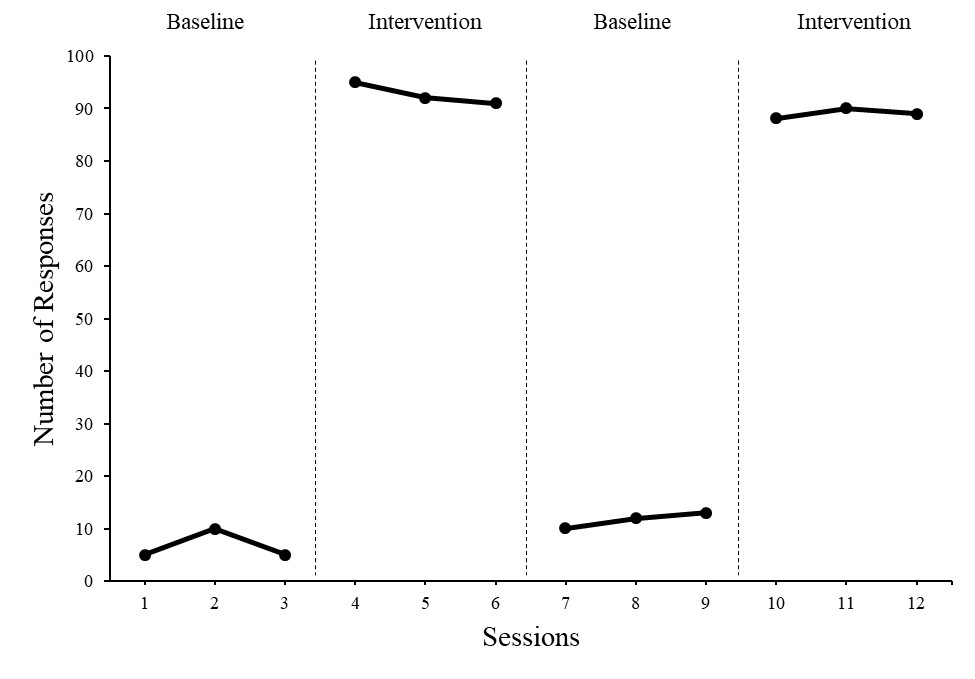
ABAB designs have the benefit of an additional demonstration of experimental control with the reimplementation of the intervention. Neither of these problems applies. Single-subject research is a group of research methods that are used extensively in the experimental analysis of behavior and applied behavior analysis with both human and non-human participants. ABAB designs have the benefit of an additional demonstration of experimental control with the reimplementation of the intervention. Additionally many clinicianseducators prefer the ABAB design because the investigation ends with a treatment phase rather than the absence of an intervention. Of experimental control and 2 obtaining precise measures of behavior. Pc Abab Reversal Graph Instructional Design Lab.

The ABAB design is superior to the ABA design because a single reversal is not strong enough for the effectiveness of the treatment. ABAB designs have the benefit of an additional demonstration of experimental control with the reimplementation of the intervention. Additionally many clinicianseducators prefer the ABAB design because the investigation ends with a treatment phase rather than the absence of an intervention. Drawbacks to ABAB and reversal designs are ethical concerns and the irreversibility of certain targets. Additionally many clinicianseducators prefer the ABAB design because the investigation ends with a treatment phase rather than the absence of an intervention. ABA therapy utilizes behavioral principles to set goals reinforce behaviors and measure outcomes. Hypothetical Example Of The Withdrawal Design Abab Notes Y Axis Download Scientific Diagram.
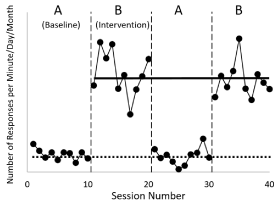
The ABAB design is intended to reveal a functional relationship between an experimental treatment and a behavior targeted for change. Designs with an especially clear demonstration of experimental control. Single Subject Designs There are two broadly defined approaches to experimental research. The A-B-A-B design is recommended for use when reversal designs can be used and when the patients treatment phase needs to be maintained. Neither of these problems applies. To demonstrate effectiveness of the treatment a change must be observed under multiple circumstances to rule. A Brief Overview Of Within Subject Experimental Design Logic For Individuals With Asd.
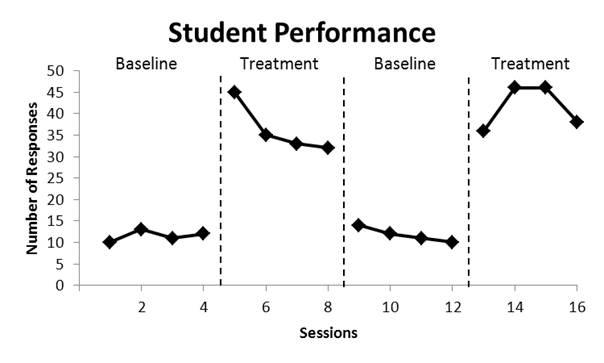
The self-injurious behaviors included pulling her hair biting her arm and banging her head against the all. Additionally many clinicianseducators prefer the ABAB design because the investigation ends with a treatment phase rather than the absence of an intervention. Neither of these problems applies. The ABAB design is intended to reveal a functional relationship between an experimental treatment and a behavior targeted for change. As an independent marketing tool an educational outlet and as a forum for colleagues parents and any other interested person who wants to know learn or discuss Applied Behavior Analysis. It is widely used and has been shown to be effective for improving specific skills and decreasing problem behaviors. Ace Lab.
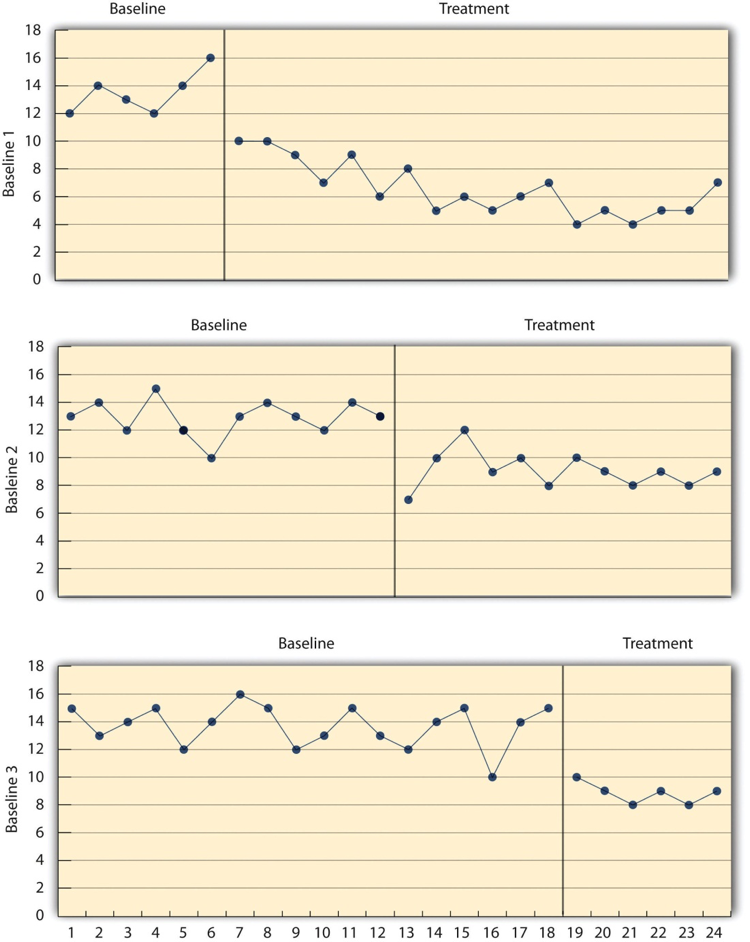
The percentage of time he spent studying the dependent variable was low during the first baseline phase increased during the first treatment phase until it leveled off decreased during the second baseline phase and again increased during the second treatment phase. The A-B-A-B design represents an attempt to measure a baseline the first A a treatment measurement the first B the withdrawal of treatment the second A and the re-introduction of treatment the second B. In order for this design to provide evidence that the intervention was effective. This approach is often described as the gold standard in the treatment of autism. Withdrawal designs also known as ABAB designs rely on the comparisons between conditions when an intervention is in place and conditions when that intervention is not being implemented. The B-A-B design is used i. Single Subject Research Designs Research Methods In Psychology 2nd Canadian Edition.

A-B-A-B designs Multi-element designs Multiple Baseline designs Repeated acquisition designs Brief experimental designs and Combined designs. In order for this design to provide evidence that the intervention was effective. To demonstrate effectiveness of the treatment a change must be observed under multiple circumstances to rule. ABAB designs have the benefit of an additional demonstration of experimental control with the reimplementation of the intervention. ABAB designs have the benefit of an additional demonstration of experimental control with the reimplementation of the intervention. ABAB Design Case study. Section 5 Experimental Designs Part 2 Flashcards Quizlet.

The study by Hall and his colleagues was an ABAB reversal design. Withdrawal designs also known as ABAB designs rely on the comparisons between conditions when an intervention is in place and conditions when that intervention is not being implemented. ABAB designs have the benefit of an additional demonstration of experimental control with the reimplementation of the intervention. In order for this design to provide evidence that the intervention was effective. ABAB designs have the benefit of an additional demonstration of experimental control with the reimplementation of the intervention. This article describes and discusses some commonly used single-case experimental designs including reversal and non-reversal designs. Sample Graph For Reversal Abab Design Study Download Scientific Diagram.










